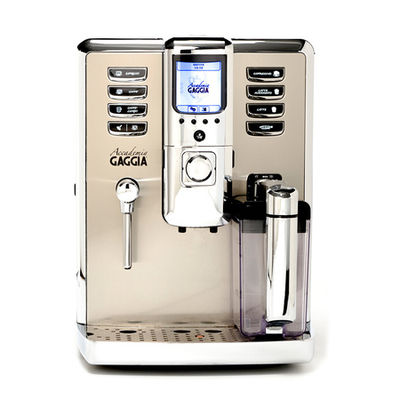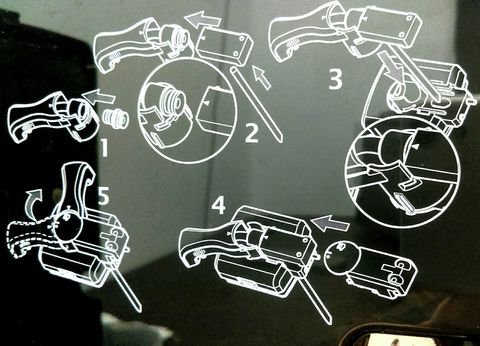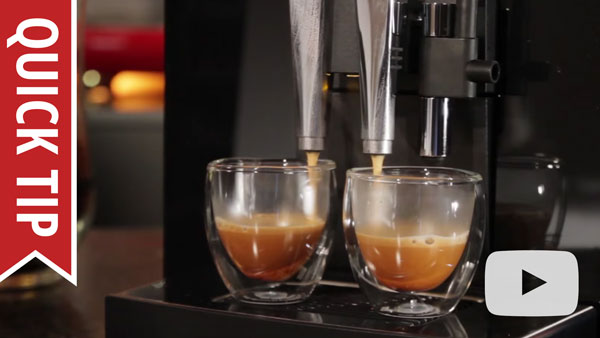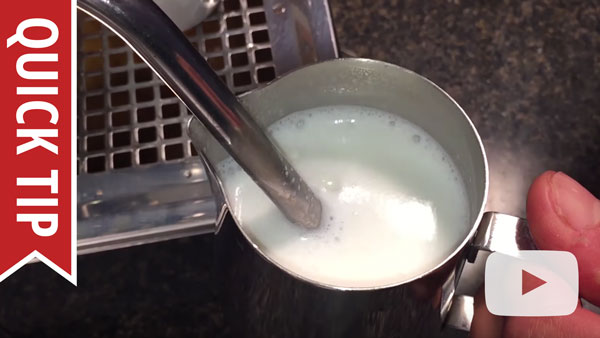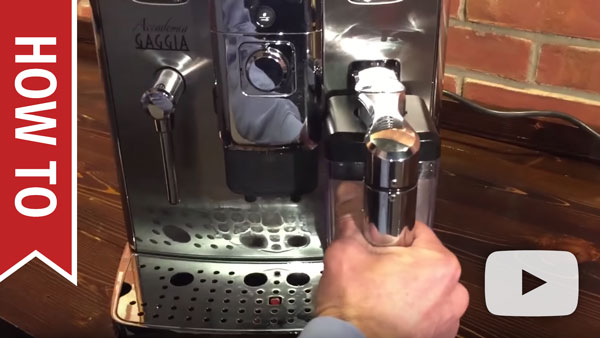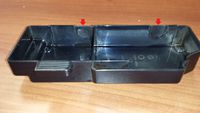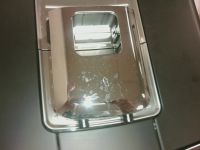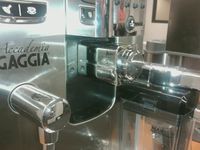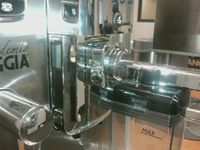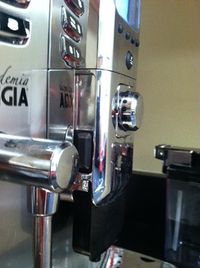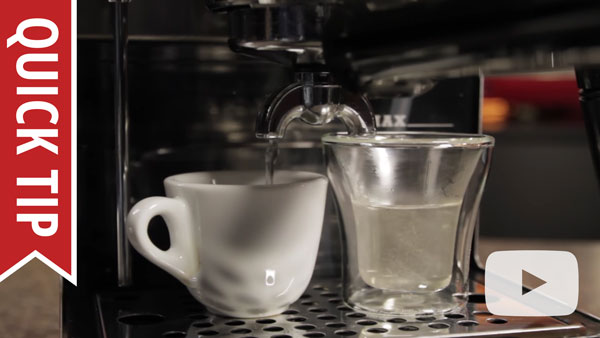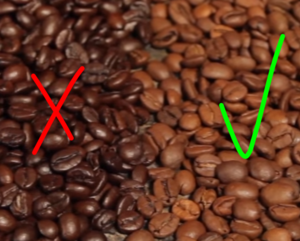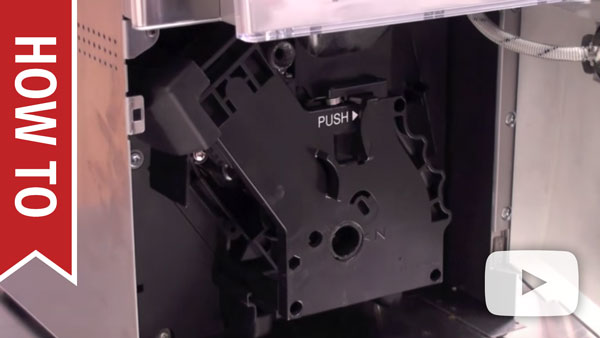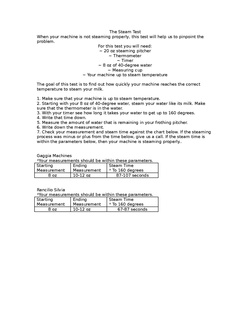Difference between revisions of "Gaggia Accademia"
From Whole Latte Love Support Library
| Line 109: | Line 109: | ||
The first place to start with any flow issue is cleaning the machine. Before going through these steps please make sure the machine is cleaned according to the [[#Cleaning & Maintenance|Cleaning & Maintenance]] section of this article. | The first place to start with any flow issue is cleaning the machine. Before going through these steps please make sure the machine is cleaned according to the [[#Cleaning & Maintenance|Cleaning & Maintenance]] section of this article. | ||
| − | + | ||
*How to test the pump on the Accademia: {{#ev:youtube|https://youtu.be/ZnETOjSN074|center}} | *How to test the pump on the Accademia: {{#ev:youtube|https://youtu.be/ZnETOjSN074|center}} | ||
Revision as of 12:35, 19 January 2018
The Gaggia Accademia is a super-automatic espresso machine that features beverage programming and an auto-frothing carafe.
| Gaggia Accademia |
|---|
| Manufacturer: Gaggia |
| Model Name: Accademia |
| Model Number: 1003380 |
| Type: Super-Automatic |
Contents
- 1 Machine Set-Up/New Users
- 2 Cleaning & Maintenance
- 3 Troubleshooting
- 3.1 No Crema or Bad Tasting Shots
- 3.2 Difficulty Frothing
- 3.3 Flow Issues
- 3.4 Machine Is Leaking
- 3.5 Machine Not Heating Or Powering On
- 3.6 No Beans, Grinder Blocked, Or E01
- 3.7 Continuous Empty Grounds Error
- 3.8 Brew Unit Max Pressure, Stuck, or E03 or E04 Error Codes
- 3.9 Too Much Steam/Milk Boiling
- 4 Diagrams & Manuals
- 5 Specifications
Machine Set-Up/New Users
There are some key differences in how Super-Automatic machines work in comparison to semi-automatic/manual units to be aware of before the first use. Having a working knowledge of the machine before using it will help ensure a satisfying experience, increase the longevity of the unit, and prevent possible issues/damage that can result from misuse. This information in this section will cover machine set up and basic use. To start, the video below provides five useful tips to help you understand your super-automatic machine:
Bean Compatibility
Before going into the set up of the machine it's best to review this topic because of its importance. The most important thing to understand about Super-Automatic machines is that they do not accept oily, caramelized, or flavored beans. The video below discusses what beans are compatible, and what beans are not:
First Time Use
The machine manual provides a thorough walk-through of the set-up of the unit, but there's so much information it can be mystifying. In this section we will walk you through the most important points of the machine setup.
Initial Setup/Priming
When the machine is first unpacked there are several things to consider before even powering the unit on. When first unpacking the unit you may notice water or grounds in the machine. This is normal as all machines are manufacturer tested before leaving the factory.
- First, make sure all of the components are fully inserted into the machine.
- If the machine came with an Intenza filter do not install it at this time. This should be installed after the machine has been fully primed and set-up.
- Plug the machine directly into an outlet. Because this is a high power unit it should not be plugged into surge protectors, extension cords, or timers. The cord of the machine can be removed from the machine itself. Please make sure the cord is secure on the end attached to the machine.
- Fill the water tank and firmly reinsert it.
- Turn the flow control dial to the completely open position. This is the dial on the front of the machine, just above the coffee spouts.
- Ensure that the spout is properly aligned on the front of the machine; the spout should be completely flush with the face of the machine. Pictures showing the proper alignment of the spout can be found in the section of this page which discusses spout alignment.
- Power the unit on. The machine should now go through an initial start-up/priming cycle. If the machine does not complete the priming cycle successfully make sure the Intenza filter is removed and the tank is firmly inserted. If the machine continues not to prime then the machine may need to be force primed. Contact Technical Support for more information if this happens -- force priming is normal and expected as the machines are drained to prevent leaking/freezing damage during shipping of the product.
- Once the machine has completed the automatic priming you will want to manually prime the unit to ensure the system is properly filled with water. To do this activate the machine's hot water function and pull 3-4 oz. of liquid through. The machine should now be fully primed, proceed to the next section.
Beans/Grinder Set-Up
After the machine has been successfully primed it is important to set the grinder for initial use. The grinder fineness setting should only be adjusted while the grinder is running if it is being adjusted in the finer direction. The finer direction is indicated by smaller dots.
- For initial use the grinder should be set to the coarsest grind setting, which will be the largest number/dot on the grinder knob. Once the dial is set you can add the beans in; make sure to only add dry beans as prescribed in the Bean Compatibility section.
- Set the aroma to the maximum setting using the aroma adjustment button. This increases how much the grinder grinds each time. This will help the grinder mechanism fill with beans/grounds faster for the next step.
- Next choose one of the brewing options. The first few shots of the machine may come out watery/weak -- this is to be expected since the beans need to feed into the grinder, and the bypass chamber needs to fill. Depending on the machine/type of bean used it can take up to 5-10 attempts.
- Once shots are pouring through consistently then settings can be adjusted. Adjustments are covered in the next section.
Drink Adjustment
The machine is now ready to brew for drinks, but the startup settings may not match the drink you are trying to brew. For the demonstration purposes this section will walk through brewing a single shot espresso from the machine.
- Set the machine to the three bean aroma setting using the aroma/preground button. This full aroma setting is typically best for espresso extraction, but can be lowered if the coffee is too strong.
- Adjust the fineness dial down to the finest grind setting, which is the smallest dot on the unit. This adjustment must be done while the grinder is running. In order to do this press one of the brewing functions to activate the grinder. When you hear the grinder activate the knob can be turned. Turn the knob gradually to prevent jamming. If you cannot get the knob all the way down to the finest setting you can always run another shot to adjust further.
- Most Super-Automatic machines come programmed to 1.5-2 oz. for the espresso option despite being single shot machines. For best results we suggest reprogramming the shot size to 1 oz. Shot sizes can be easily reprogrammed on this unit by pressing and holding the drink button you would like to reprogram. Hold the button for at least 5 seconds until the grinder activates and then let go. Use a measuring device to measure the liquid volume being dispensed. Once you have 1 oz. in the measuring device press the same brew option to stop the brewing and save the new amount.
- One really important thing to consider for this machine is that it uses a smart grinder. Smart grinders make gradual adjustments to how the beans are ground and how much coffee is dosed each shot. After an adjustment is made the machine will typically take 10-15 shots for best results. The grinder will make gradual changes based on the new adjustment to improve the flavor of the coffee each time. For this same reason constant adjustments should not be made to the machine, as the smart grinder will not have enough time to respond to the adjustments.
- The video below discusses how to adjust for other types of drinks. The general rule of thumb is that the more liquid volume passed through the grinds the coarser the grind should be set in order to get a balanced extraction.
Puck Consistency
A large misconception is that super-automatic machines should have a dry coffee puck after the machine is finished brewing. While this is true of other styles of espresso machine, this is not true of a super-automatic unit. Super-automatic machines utilize heat and pressure as part of the brewing process, which is key to espresso brewing. The machine achieves this through a device called a brew unit. The brew unit uses a similar but different brewing process to a semi-automatic or prosumer style machine. As a result the pucks will not always come out firm and dry. They may come out muddy or broken. This is perfectly normal; the machine will still produce a good extraction that contains crema and tastes good.
Bypass Doser
If you plan on using the bypass doser function on the machine to brew with pre-ground coffee there are a few things to consider for the best brewing experience:
- The bypass doser will only accept 8-9 grams of coffee at a time. The scoop that comes with the machine is merely for transferring coffee grinds, it is not a measurement tool. To prevent overfilling the bypass doser we suggest using a level scoop, and then taking a large pinch out of it. A little bit less than a full scoop is the perfect amount.
- Make sure to use the aroma button to activate the preground mode before beginning the brew, otherwise the machine will also grind coffee, which will result in too much coffee going into the brew unit and the machine will abort the brew.
- If the coffee is ground too coarsely the resulting shot is going to taste sour, weak or watery. Coarsely ground coffee also does not compact well, so the machine may dump the coffee if the grind is to coarse. Coffee ground for espresso should be slightly finer than table sugar or sand.
- Alternatively it is also possible to have coffee that is ground too fine. Extremely fine grinds can result in little or no flow from the machine, and very bitter shots. Coffee that is ground too finely can cause blockages in the system that can only be resolved through deep cleaning or a repair.
Do not add whole beans, or entire bags of preground coffee into this chamber. It can cause irreversible damage to the machine's brewing assembly.
One useful trick the the bypass function allows for is that you can do a quick rinse of the brew circuit by simply running a bypass cycle and not adding any preground coffee. This will let plain water flow through the brew circuit which will remove old coffee flavors, oils, and grounds. You may want to do this if you've recently switched beans to remove some of the old flavors.
Brew Unit/Pump Noises
When Super-Automatic machines are in operation the brew unit will make a few different noises which are normal. The brew unit will make several loud clicking noises through the duration of the brewing cycle. These loud clicking noises are perfectly normal and will not harm the machine. The brew unit function is monitored by sensors to prevent it from being overloaded, so it cannot break itself apart.
The brew unit can also make squeaking noises during its operation. The squeaking could be from o-rings sealing on the brew unit, or the brew unit parts sliding along the tracks. If you are hearing more squeaking than normal it may be a sign that the brew unit needs to be cleaned and lubricated. Some squeaking is also normal on very new units as there are o-rings/seals that need some time to wear in.When the pump of the machine activated for brewing, refilling, and hot water dispensing it is going to make a loud humming noise. The machine utilizes a vibration style pump. This style pump produces high pressures despite being compact. The pump achieves this through rapid vibration of internal parts, which produces a loud humming noise.
Mavea Intenza Filter
Once set-up has been fully completed the filter can be installed. Installing the filter beforehand could cause the machine to become vapor locked and require manual priming. Follow the instructions on the filter packaging before installing it. The instructions will indicate the filter needs to be activated by soaking in water before it is installed. If the machine gives a priming error when the filter is installed simply remove the filter and soak in warm water upside down for at least an hour and then reinstall it.==Machine Set-Up/New Users==
There are some key differences in how Super-Automatic machines work in comparison to semi-automatic/manual units to be aware of before the first use. Having a working knowledge of the machine before using it will help ensure a satisfying experience, increase the longevity of the unit, and prevent possible issues/damage that can result from misuse. This information in this section will cover machine set up and basic use. To start, the video below provides five useful tips to help you understand your super-automatic machine:
Spout Alignment
The alignment of the machine's spout is important for the machine to function properly. If the spout is misaligned it can result in leaking, poor/no flow, or sensor malfunction. Please review the spout alignment section of this article for pictures and descriptions of how to properly align the spout.
Cleaning & Maintenance
Proper machine maintenance is critical to proper machine functionality. Most machine failures are caused by a lack of cleaning and maintenance. This is vital, as many manufacturer warranties do not cover cleaning/maintenance related breakdowns. To avoid this, it is imperative to keep a regular maintenance schedule. Consult pp. 36-53 in your machine manual for fully detailed cleaning procedures, including descaling, carafe cleaning, and brew group cleaning, as well as the recommended products for machine maintenance. Listed below is a suggested maintenance rundown for most super-automatic espresso machines:
Machine Maintenance
Descaling
Descaling the machine should be done on a bimonthly basis using the product recommended by the manufacturer. Descaling is still required even if reverse osmosis, distilled, or zero water is being used. Refer to your machine manual for specific instructions for this unit.
Brew Unit
The brew unit of the machine should be removed on a weekly basis and rinsed off with cold water. Cold water must be used because hot water can wash away the lubricant that coats the moving parts of the brew unit. It is also important to use plain water; detergents and soaps should not be used. While the brew unit is removed, the brew unit chamber should be wiped down with a moist cloth to remove excess grounds and coffee residues.
Your machine features a brew unit cleaning cycle. This should be done on a monthly basis; refer to your manual for instructions on how to run one.
A complete disassembly, cleaning, and lubrication of the brew unit should be done every 500 cups or every 6 months, whichever comes first. A food safe silicone-based lubricant should be used, such as food grade Petrol-Gel.
Steam Wand Cleaning
Steam wands and nozzle attachments should be cleaned daily, after the machine is finished for the day. Milk residues quickly build up in steam wands and frothing nozzles, so it is important to keep these clean to prevent blockages from forming.
Recommended Cleaning Products
The best descaling product for this machine is Durgol Swiss Espresso Descaler. The suggested tablets for running brew unit cleaning cycles are the Gaggia Coffee Clean Tablets or Urnex Full Circle Espresso Machine Cleaning Tablets.
Milk Carafe Maintenance
Instructions for carafe disassembly and maintenance can be found on the inside of the Accademia's service door.
Automatic Cleaning Cycle
The automatic carafe cleaning cycle for this machine should be completed on a weekly basis. It is important to keep the carafe clean, in order for the carafe to function properly and produce froth. Unsanitary milk residues can build up in the carafe if it is not maintained properly. A full carafe cleaning cycle can be activated through the machine's maintenance menu.
Manual Disassembly & Cleaning
While the automatic cleaning cycle does remove most residues, it is not a complete cleaning of the carafe. For more thorough cleaning, the carafe should be pulled apart on a daily basis after you are finished making latte drinks for the day. Please see the video below for instructions on how to complete the manual carafe cleaning. The machine featured in the video is different, but the process for disassembling the carafe is identical. There is also a diagram of the carafe disassembly on pp.43-45 of the machine manual.
Recommended Cleaning Products
The automated carafe cleaning cycle requires the use of a cleaning solution intended for removing milk residues. The recommended cleaning solution for the milk carafe is Rinza.
Troubleshooting
No Crema or Bad Tasting Shots
Typically, issues with crema or the flavor of the shot do not indicate a malfunction of the machine. Instead, this indicates that an adjustment needs to be made in the brewing process or that different beans need to be used.
The type of bean that is being used is particularly important for super-automatic machines, because the built in burr grinders only accept certain types of beans. Another consideration is the roast of the bean, which greatly influences how much crema can be produced, as well as the flavor of the shot. Super-automatic machines are not compatible with oily, caramelized, or flavored beans. Properly stored and recently roasted beans are best. You can find more information on why bean selection and storage is important for super-automatic machines by watching the video below.
Appropriately adjusting the grinder is also important. Poor shots can also be the result of incorrect grind settings.
- If the shot is too bitter:
- The grind is set too fine. Try adjusting the grind to a coarser setting, typically indicated by a large dot symbol or higher number.
- If applicable, the aroma setting is set too high. Lower the aroma setting so that less coffee is ground per shot.
- The beans being used are over-roasted, and a lighter roast is needed.
- If the shot is too sour or weak tasting:
- The grind is set too coarse. Try adjusting the grind to a finer setting, indicated by a lower number. Whenever moving the grind to a finer setting it is important to make minor adjustments, and to only adjust the grinder while in operation.
- If there is little crema:
- The beans are probably stale and fresher beans need to be used.
- The grind setting does not match the drink that is being made. Smaller drinks such as an espresso require finer grind size; larger drinks such as a longo require a coarser grind.
- Oily or dark roasted beans are being used. These beans are not compatible with the unit, and are not suitable for espresso brewing. The oils and chemicals that are needed to produce a rich crema have been roasted out of the bean. Switch to a drier/lighter roast.
- Keep the machine properly cleaned and maintained for good tasting shots. Your grinder may need to be cleaned or calibrated, or you may need to descale your machine to remove any unwanted residues or flavors.
Difficulty Frothing
Wand Frothing Issues
If the machine has little to no steam flow through the steam wand, first check to make sure there are no blockages in the steam wand. Otherwise, an adjustment to frothing technique needs to be made. When manually frothing, technique is key. Tight microfoam will not be accomplished if the proper technique is not followed.
The following video shows how to properly froth with a manual style wand:
There are also some common mistakes made when manually frothing that should be avoided. The video below gives further details:
Carafe Frothing Issues
Before going through the following steps make sure to try all of the recommended Milk Carafe Maintenance steps have been done.
- If there is nothing coming out of the carafe at all:
- Check the carafe to make sure it is securely attached to the machine and that the machine recognizes the carafe is in place. To ensure this, you can remove the carafe and re-insert it.
- Make sure the carafe is properly assembled. Inspect the parts to make sure none of them appear broken, damaged, or missing. There is a diagram of the carafe disassembly on pp.43-45 of the machine manual. here.
- The machine may not be producing steam because of a thermostat issue. If the machine gives an E15 error code, or it gets stuck heating up the steam circuit, then the machine will need to be repaired.
- If the carafe is spitting or not producing foam:
- The machine is set to a low froth setting. Check the machine settings to make sure it is set to the maximum froth. There is also a milk setting, which should also be set to max. Press the list icon, followed by the check to enter the Beverage Menu. From there, you can select your different drink options and adjust their specific qualities. Milk Amount is listed here.
- A non-compatible milk is being used. The machine is designed for use with whole or 2% milk, so the best results will be achieved by using these varieties.
- Make sure the carafe is properly assembled.Inspect the parts to make sure none of them appear broken, damaged, or missing. There is a diagram of the carafe disassembly on pp.50-51 of the machine manual.
Flow Issues
The first place to start with any flow issue is cleaning the machine. Before going through these steps please make sure the machine is cleaned according to the Cleaning & Maintenance section of this article.
- How to test the pump on the Accademia:
No Flow From Steam Wand
Once the flow issue has been resolved the machine should be immediately descaled with the recommended product. Flow issues and blockages are typically due to lack of maintenance or excessive scale buildup.
- First set the machine to hot water mode. If the machine has a pannarello or turbo-frothing attachment on the wand remove it for the remaining steps.
- If the machine displays an E15 error code, or the machine gets stuck on the heating up screen, then there is a thermostat issue and the machine will need to be repaired.
- You should hear the pump start to vibrate. Once the pump is activated, hot water should begin to flow through the wand, however:
- If hot water flows through the wand, stop the machine from dispensing hot water and switch to steam mode. There may have been a piece of debris in the steam wand blocking the flow.
- If water does not flow through the wand then there may be a more severe blockage.
- Soak the wand in a mixture of descaler and hot water. Test flow using the hot water function again.
- Use a pipe cleaner to manually clean the inside of the wand. Only use a pipe cleaner with synthetic or plastic bristles; do not use one with metal bristles as it can damage the wand. Test the flow again.
No Steam Or E15 Error
- If the carafe works, but the steam wand does not, then do the recommended steam wand cleanings.
- If the steam wand works, but the carafe does not, then do the recommended milk carafe cleanings.
- If the machine gives an E15 error or is stuck on the heating up screen, then the machine’s thermostat is damaged and will require repair.
- If temperatures are not hot enough for the carafe there are a few things to try.
- The carafe may in fact be operating properly. The carafe was designed for use with a room temperature boxed milk. The machine is programmed to produce a temperature rise of 50-70 F°. Typical ending temperatures are around 125-135 F°. However, this is completely dependent on the starting temperature of the milk being used. If the milk is stored in a very cold refrigerator (e.g. a 33 F° refrigerator) the resulting temperature will only be about 100-110 F°. For hotter milk drinks, start with warmer milk, either by leaving it out for a little bit before making your beverage, or putting the milk in the microwave for about 10 seconds prior to adding it to the milk carafe.
- There are a few programming options which can be changed in order to increase the amount of steam that is injected into the carafe during frothing. Make sure the milk drink options are programmed to the highest temperature. This will also help to set the foam and milk options to max.
Reduced Or No Flow During Brewing
- If there is no flow while brewing specifically, then something is blocked along the brew circuit. Begin by running a descale of the machine using the recommended product. Scale buildup is the most common cause of flow issues. Descaling will most likely resolve the issue.
- If the machine is set to a really fine grind, the grinds can block the flow. Set the grind to a coarser setting and see if flow is restored. Leave the grind on the coarse setting for the remainder of flow testing.
- There may be an issue with the brew unit.
- First remove the unit and rinse it off with cold water. Do not use any sort of detergent or soap to rinse it off or necessary lubricant will be removed.
- Wipe down the brew unit chamber with a damp cloth to remove any leftover grounds. A microfiber cloth is best, to prevent any cloth fibers from remaining behind.
- Clean the check-valve. Here are the instructions to follow.
- Reinsert the brew unit and test for flow.
- This machine allows beverage length to be reprogrammed. Make sure it isn't set to the minimum brew length. If the machine is programmed to the minimum beverage length the machine may not dispense any coffee, or it may only dispense a few drops. Try reprogramming the machine to a longer length drink to see if it resolves the no flow issue.
- Check the brew unit to make sure it is lining up with the spout assembly and connecting with the spout assembly properly.
- If you are noticing a lot of brewed coffee or coffee sprayed inside the brew unit chamber then the brew unit o-ring may be damaged or out of place.
- Remove the brew unit and inspect the large red o-ring attached to the tamping assembly. Make sure it is clean, properly positioned, and not damaged.
- If the o-ring is broken or damaged it should be replaced. A brew unit o-ring can be purchased here.
- Your machine features an e-plus dial which may be blocked. Try brewing a shot and while the pump is activated turn the e-plus dial back and forth. This may clear up the blockage and restore flow.
- The dispensing spout may be blocked. Try very gently cleaning the dispensing spout holes with a toothpick to remove any blockages.
Have Flow But Getting No Flow Error
In some situations, you will be able to get flow through the machine for all functions, but the machine thinks there is no water flowing through. There is a device in the machine called a flow meter, and it tells the machine when water is flowing through or not. The device operates by having small fan-like blades spin when water passes through it. If those blades get stuck from excessive scale buildup or debris, then they will not spin. As a result, even though water is flowing through the machine, you will get a flow error.
If your machine uses a water filter, temporarily remove it from the water tank and add the recommended descaling product to the water tank. The descaler needs to work its way into the system to start dissolving the scale buildup in the flow meter. You may have to keep restarting the machine so that it can keep attempting to prime, which will draw the descaler/water solution into the system. If at any point you are able to clear the flow message then you will want to do an immediate descale of the machine. After you have descaled, run 4-5 tanks of plain water through the hot water function for the wand in order to ensure the system is completely free of debris.
Machine Is Leaking
From The Bottom
- Check the internal drip tray to make sure it isn't cracked or overflowing. If the drip tray is overflowing, this may be because the drip tray was removed but not emptied. Anytime the drip tray is removed from the machine while the machine is powered on, the drip tray sensor will reset to zero, tricking it into thinking it had been emptied. To prevent overflow, make sure the drip tray and grounds drawer are emptied any time they are removed from the machine.
- Older Accademias have an old style drip tray, which has rubber grommets on the back. If one of the grommets is missing, the drip tray will need to be upgraded to the new style, which can be purchased here.
- Make sure the spout is aligned properly on the front of the machine. If the dispensing spout is improperly positioned, the machine will leak from the bottom of the door, because water/coffee will be forced into the inside of the door. This can cause damage to electronics that are contained within the door, and will also result in leaking from the bottom. The dispensing spout should be flush with the very front of the square arm that it slides onto.
- Open the front door of the machine and check the back side of it. There should be a tube sticking out of the door about midway down. This tube mates with the injector nozzle from the brew unit. If this tube is damaged or missing coffee will spray on the back of the door, which can possibly result in fully brewed coffee leaking from the bottom front of the machine.
- The leaking is coming from the water tank chamber.
- If the water tank is not positioned properly it can cause water to continuously drain from the tank, even while the machine is turned off. This happens when the water tank is inserted far enough to open the release valve, but not far enough to seal with the intake line. Excess water in the water tank chamber is redirected to the internal drip tray through a separate drain hole. When this happens, the internal drip tray will fill and overflow with clear water. Make sure there isn't any debris which could be blocking the tank from seating properly. Then firmly reinsert the tank into the machine, and press down on it to make sure it creates a good seal.
- If the machine is leaking from the back left, especially when one of the functions is drawing water through the system, then the intake line is damaged or disconnected. This will require a repair.
From The Wand
If the steam wand is leaking while the machine is on and/or brewing, the steam valve is open inside the machine. It is likely that scale has built up inside the valve, and the buildup is holding the valve open. Try the following to resolve the leak:
- First begin by descaling the machine using the recommended descaling product.
- After descaling flush 4-5 tanks of plain water through the system using the hot water function for the steam wand. This will ensure any debris or scale buildup the descaling loosened is fully removed.
- If this does not work then the machine should be sent in for repair since the steam valve may need to be replaced.
From Dispensing Spout
If coffee is leaking around the spout assembly, or from the front of it, then it is not properly positioned on the machine. The spout assembly is designed to be removed for cleaning and to make room for larger beverage containers. When the spout is aligned incorrectly it is going to cause coffee to flow through the machine incorrectly. It can cause coffee to leak around the spout, or even leak from the bottom of the front door, because the coffee is being redirected incorrectly.
Here is what the machine looks like when the spout is removed. The spout is not a necessary component; when it is removed the machine will brew a single stream instead of a split stream.
Here is what the spout looks like when it is pushed too far back. The spout can also be pulled too far forward. This is what causes the spout to leak.
The spout should be positioned this way. It should be completely flush with the matching shape of the upper screen assembly. The beveled edges should be aligned, and the rectangular protrusion the e-plus dial attached too should be flush with the spout as well.
Machine Not Heating Or Powering On
No Power
- Make sure the machine is plugged into an appropriate power source.
- Do not use the machine on a surge protector. This machine has a high power draw, more than a typical kitchen appliance such as a refrigerator or a microwave. Surge protectors are typically not rated to handle the amperage this machine requires.
- Make sure the power cord is firmly inserted into the power socket on the machine.
- Try using the machine on a different outlet, and make sure the machine is the only appliance plugged into that outlet.
- Try testing another appliance on the same outlet.
- Make sure the power switches are functioning properly and not broken. If the machine isn't powering on try pressing and holding the power button in the on position to see if the machine turns on. If you are able to power the machine on this way then the power switch needs to be replaced.
- If the machine recently had a leak, had water spilled on it, or any other exposure to moisture then the machine may be shorting out. Try letting the machine sit unplugged for 48 hours to make sure there isn't a short caused by moisture.
Stuck In Standby Mode
If the machine does not come out of standby mode after pushing the button or if it turns itself off the machine will need to come in for service. Make sure to press on the power button firmly when attempting to bring the machine out of standby. It may be worth trying to let the machine dry out for 48 hours with the front door open, in case the machine was exposed to moisture.
Cold Shots or E14 Error
- If the machine is producing shots that are hot, but you would like them to be hotter, check the beverage programming menu. Make sure all of the drinks are set to brew at the highest temperature.
- Make sure you are using a preheated cup. Ceramic cups will sap a lot of heat from the shot resulting in a colder shot. Preheating the cups using the machine's hot water function will allow the cup a great deal more heat. Alternatively, you can brew into a paper, styrofoam, or other well insulated cup. This video explains the importance of a pre-heated cup during espresso brewing:
- If the shots are completely cold, or the machine is displaying an E14 error code, then there is a thermostat issue. Try restarting the machine to resolve the issue. If the error code continues to appear, then the thermostat is damaged and the machine will need to be repaired.
No Beans, Grinder Blocked, Or E01
All three of these issues share the same root cause. The grinder has become jammed with grounds or coffee residues. These issues are typically a result of incorrect beans being used in the machine. This machine is not compatible with oily, dark roasted, caramelized, or flavored beans. Use of these beans can cause permanent damage to the machine that is not covered under warranty. These beans can be identified easily. They will be shiny and feel slippery or sticky. Dry beans that are appropriate for the machine will look dull and feel rough. This machine does not have a user serviceable grinder so it is very important that the correct beans are used. Follow these steps to fix the behavior:
- Remove all of the beans and set them aside.
- Move the grinder adjustment dial all the way to the coarsest setting.
- Use a vacuum to thoroughly clean out the grinder. In particular vacuum down in the chute where the beans feed into the inside of the machine.
- Add beans back into the machine. The beans must be dry beans. Do not add incompatible beans back into the unit. Make sure the grinder is still set to the coarsest setting.
- Test the machine to see if it can successfully brew a shot. If it successfully brews, run 2-3 more shots on this grind setting so that we can be sure the system is free of the old coffee grounds.
- Once the machine is functional on this setting you can begin adjusting the grind to your preferred setting. Make small, one-tick-at-a-time adjustments, and be sure to brew shots in between. This will prevent the machine from jamming again.
Continuous Empty Grounds Error
If the “empty grounds drawer” or “empty drip tray” message will not clear, then one of the drip tray sensors may be malfunctioning. This can happen if the spout on the front of the machine is improperly positioned, causing brewed coffee to spray inside the door where several electronic sensors are located. If these sensors get wet, they can temporarily short out, or they may be permanently damaged and require repair. Follow the steps below to resolve the issue.
- First, you should review your spout alignment.
- Make sure that you are emptying the grounds drawer/drip tray while the machine is turned on and out of standby. The machine will not reset the counters for these sensors unless it is powered on. Once removed, wait fifteen seconds or so before reinserting.
- Remove the spout completely from the machine. It will pull straight forward for removal.
- Unplug the machine.
- Open the front door and prop it open. Leave the machine like this for at least 48 hours. If the sensor is wet but still operational, it needs time to dry out before the machine will function again. A small fan blowing on the back of the door will assist in drying the unit out.
- Reassemble the machine. Ensure that the brewing spout is perfectly aligned. Alternatively, it can be left off the machine and coffee will come out in a single stream instead.
- If the machine it still displaying the error message try emptying the grounds drawer and drip tray while the machine is on. If the message still does not clear after doing this then the drip tray sensor is damaged and the machine will require a repair.
Brew Unit Max Pressure, Stuck, or E03 or E04 Error Codes
The machine is sensing that the brew unit motor is working too hard to engage the brew unit. This is a fail-safe built into the machine to prevent itself from damaging the brew unit; the machine will stop working and display an error. This issue is typically resolved through normal maintenance.
- First restart the machine to clear the error message and reset the brew unit back to the home position so that it can be removed. If the machine is in an active rinse cycle do not try to remove the brew unit. The rinse cycle must be completed before the brew unit can be removed.
- Try running a blank bypass shot. To do this just run a normal bypass shot but do not add any coffee. You should just have plain water come out of the spouts. If the machine successfully completes this cycle then we know it's a coffee issue. Refer to the section of this article that discusses grinding issues.
- If this happened when you were using the bypass function specifically, then you may have added too much pre-ground coffee. The machine only accepts about a maximum of 8-9 grams per shot. The scoop that comes with the machine doses more than this. To make sure you are adding the appropriate amount take one level scoop of pre-ground coffee and remove a large pinch from it. This should about about 8 grams of coffee and should work in the machine.
- When the machine indicates that it is ready for use open the door to the brew unit chamber.
- Try removing the brew unit. If the brew unit does not come out easily, do not force it out. The brew unit is stuck in an engaged position and will need to be properly reset. Forcing it out of the machine can break the brew unit and possibly cause damage other parts of the machine. Follow the instructions in the video below to reset the brew unit before moving on to the next step. If the brew unit won't reset to the home position, the motor that manipulates the brew unit may be damaged, and the machine may require a repair.
- If the brew unit is easily removed then rinse it off with cold water and let it dry.
- The brew unit will need to be cleaned and lubricated.
- Reinsert the brew unit into the machine and try brewing a shot.
Too Much Steam/Milk Boiling
If you think your wand is producing too much steam, or your milk looks like it is boiling, then you may need to make an adjustment to your frothing technique. Boiling milk, or milk that is getting to hot before frothing is completed is an indication that incorrect frothing technique is being used. Review the section of this article that addresses frothing difficulties for more information.
If you have tried adjusting your technique and the wand still appears to be producing too much steam, then a steam test should be completed.If the machine is within the specified steam test range, then the machine is producing the correct amount of steam and an adjustment to frothing technique is necessary. Using a carafe that is chilled in a freezer before frothing is helpful for keeping the milk cooler for longer, allowing for more time to froth before the milk begins to scald.
Diagrams & Manuals
| Gaggia Accademia | |
|---|---|
| Accademia Error Codes and Troubleshooting: | 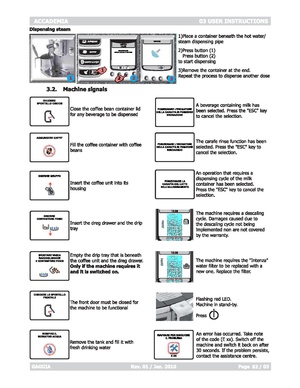
|
| Electrical Diagram: | 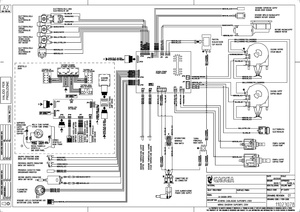
|
| Hydraulic Diagram: | 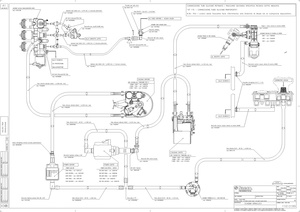
|
| Machine Manual: | 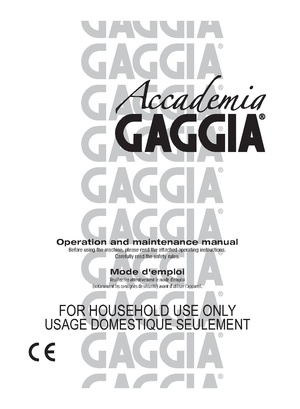
|
| Parts Diagram: | 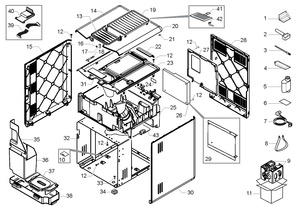
|
| Service Manual | 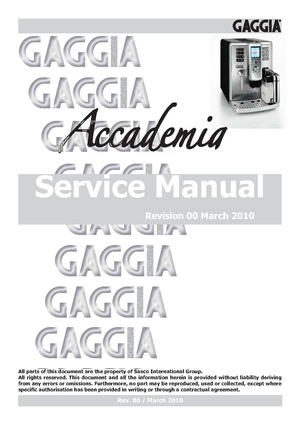
|
| Startup Guide: | 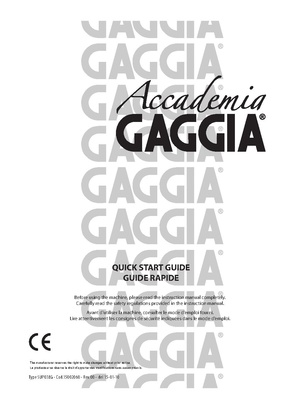
|
Specifications
| Basic Specs | |
|---|---|
| Width: | 11 in. |
| Height: | 15.2 in. |
| Depth: | 16.8 in. |
| Weight: | 43 lbs. |
| Watts: | 1500 |
| Volts: | 120 |
| Housing | |
| Housing Material: | Stainless Steel/Plastic |
| Bean Hopper Material: | Plastic |
| Drip Tray Material: | Plastic |
| Drip Tray Cover Material: | Stainless Steel |
| Drip Tray Capacity: | 10 oz. |
| Ground Coffee Container Material: | Plastic |
| Drain Line Adaptable: | No |
| Spend Coffee Capacity: | 15 |
| Easy To Rotate: | No |
| Tall Legs: | No |
| Power Cord Length: | 36 in. |
| Cup Height | |
| Adjustable Height: | Yes |
| Max Height: | 6.5 in. |
| Min Height: | 3 in. |
| One Touch Cappuccino | |
| One Touch Cappuccino: | Yes |
| One Touch Device: | Milk Carafe |
| Adjustable Froth Quality: | Yes |
| Height: | 5.5 in. |
| Separate Manual Steam Wand: | Yes |
| Programmable: | Yes |
| Milk Carafe Type: | Plastic Attachable |
| Self-Cleaning: | Yes |
| Dishwasher Safe: | No |
| Frothing Wand | |
| Material: | Plastic |
| Wand Style: | Commercial Style |
| Movement: | Privot Side To Side |
| Usable Length: | 2.5 in. |
| Height Off Counter: | 5 in. |
| Optional Cappuccinatore: | No |
| Number Of Holes: | 1 |
| No Burn Wand: | Yes |
| Optional Tips Or Wands: | No |
| Water Source | |
| Reservoir or Plumbed: | Reservoir |
| Reservoir Capacity: | 54 oz. |
| Reservoir Material: | Plastic |
| Reservoir Access: | Top |
| Reservoir Removable: | Yes |
| Water Filter: | Mavea Intenza |
| Water Level Visible: | No |
| Controls | |
| Adjustable Coffee Strength: | Yes |
| Type of Controls: | Push Button |
| Display Type: | LCD |
| Programmable Brewing: | Yes |
| Temperature Control: | Yes |
| Adjustable Coffee Dosage: | Yes |
| Digital Display: | Yes |
| Clock/Timer: | Yes |
| Coffee Dosage Quantity: | 7-10.5 grams |
| Cup Volume Control: | Yes |
| Flow Control: | Yes |
| Auto Shut Off: | Yes |
| Bypass Doser: | Yes |
| Pre-Infusion: | Yes |
| Low Water Warning: | Yes |
| Energy Saving Mode: | Yes |
| Descale Warning: | Yes |
| Multiple Programmability: | Yes |
| Pressure Gauges: | No |
| Brew Temp Display: | No |
| Cup Warmer | |
| Material: | Stainless Steel |
| Size: | 4 in. x 6 in. |
| Type: | Active |
| Brew Group | |
| Material: | Plastic |
| Type: | Automatic |
| Preheat: | No |
| Removable: | Yes |
| Self-Cleaning: | Yes |
| Boiler Data | |
| Number Of Boilers: | 2 |
| Brew And Steam Simultaneously: | No |
| Rapid Steam: | Yes |
| Brew Boiler Data | |
| Type: | Thermoblock |
| Wattage: | 1400 |
| Volume: | Low |
| Material: | Stainless Steel Lined Aluminum |
| Element Location: | External |
| Insulated: | No |
| Steam Boiler Data | |
| Type: | Thermoblock |
| Wattage: | 1400 |
| Volume: | Low |
| Material: | Stainless Steel Lined Aluminum |
| Element Location: | External |
| Insulated: | No |
| Pump Data | |
| Type: | Vibration |
| Max Pressure: | 15 Bar |
| Self-Priming: | Yes |
| Grinder Data | |
| Number Of Grind Settings: | 8 |
| Hopper Capacity: | 12 oz. |
| Burr Type: | Flat |
| Burr Material: | Ceramic |
| Freshness Lid: | Yes |
| Performance: | |
| Initial Heat Up: | 72 s. |
| Recommended Heat Up: | 72 s. |
| Brew Temp (2 oz.): | 167 F° |
| Brew Time (2 oz.): | 18 s. |
| Brew Temp (8 oz.): | 167 F° |
| Brew Time (8 oz.): | 57 s. |
| Time To Produce Steam: | 15 s. |
| Time To Steam Milk (8 oz.): | 81 s. |
| Maximum Effective Froth Duration: | 120 s. |
| Hot Water Temp (8 oz.): | 165 F° |
| Hot Water Time (8 oz.): | 53 s. |
| Hot Water Recovery Time: | 0 s. |
| Sound Level Brewing: | 66 Db |
| Sound Level Grinding: | 70 Db |
| Details | |
| Maintenance Alerts: | Yes |
| Country of Manufacture: | Italy |
| NSF Certified: | No |
| Recommended Application: | Home/Office |
